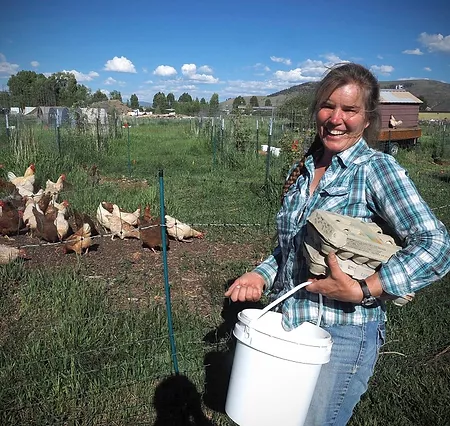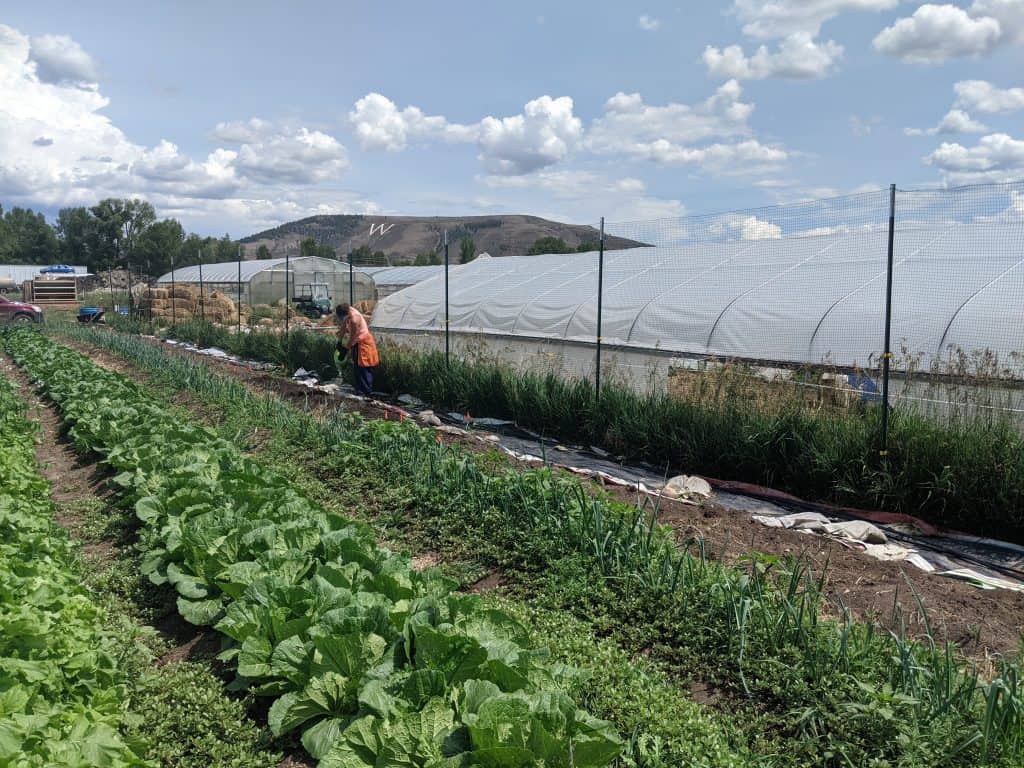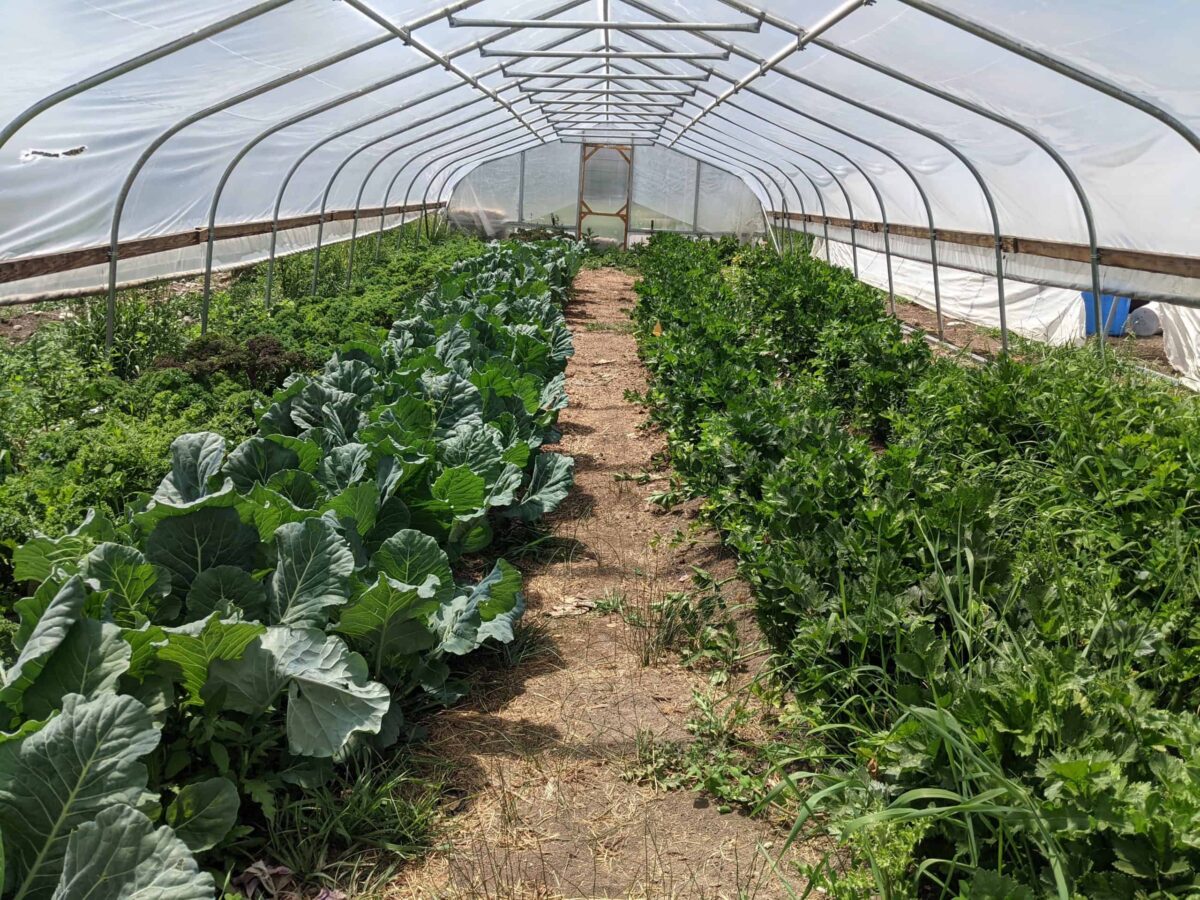
“Our food—not only does it taste really good, but people will tell me at the farmers market — our spinach makes people feel good. They can feel it on a cellular and energetic level,” notes Sue Wyman, the founder of Gunnison Gardens, a diversified local farm leading the charge in the valley’s expanding agricultural scene.
Gunnison Gardens — occupying four acres on the western end of town — is able to grow a wide variety of crops in a densified manner, including spinach, cauliflower, broccoli, garlic, radishes, onions, potatoes, celery, cucumbers, summer squash, tomatoes, mache, carrots, green beans, snow peas, and various herbs.
“Our farm is regenerative in a few ways — we get some restaurant scraps and feed them to our chickens, and then everything the chickens poop out fertilizes our beds — that’s recycling our nutrients,” adds Wyman.
In the winter, Sue’s roughly 300 egg-laying chickens, which are broken out into three age cohorts, occupy the high tunnels. During the summers, the chickens move out to pasture when the tunnels become too hot, and Wyman replaces the chickens with a warm weather crop — maximizing the usage of indoor space.
“If the [chickens] are out on pasture — they’re eating green grass and bugs and they’re fertilizing the trees and shrubs. They’re manure is super high in nitrogen, so it’s really good for the ground to run chickens,” adds Wyman.
“It’s also good for them because they get to eat all the green things — although if you don’t move them often enough they will totally decimate your grass,” she explains. “We sell both eggs and meat birds, and that’s 50 to 60 percent of our revenue.”
“We typically do our meat birds 300 in a batch. Last year we had three batches of 300, and this year we might only do two because it’s already so late in the season,” Wyman explained to me on a tour of her operation back in May.
Compared to many large-scale producers, the birds Wyman raises take a fair amount longer to mature for the market.
“If you’re a factory farm like Tyson Foods, you’re looking at six weeks. For us, it’s more like 13 weeks minimum. What we do is we get straight run birds — straight run means it’s a mix of male and female, so they mature at different rates,” she adds.
“The first 90 or so roosters will get the biggest first, and we’ll process them. Two weeks later we’ll do a mix of the later roosters and the earliest hens, and the last batch will be all hens — typically it’s 13, 15, and 17 weeks…easily twice as long as the factory farm”
Sue says the difference in maturation time is a combined result of breed, altitude, and temperature. The meat birds live inside “hoop coops” at night, but have access to the surrounding pastures for grazing.
“There’s really no access to insulation [in the hoop coops] — no protection. It’s cold in Gunnison at night, even in the middle of July. That means that they have to eat more food, and they grow a little more slowly.”
The final portion of Gunnison Gardens that Wyman shows me is the shrub and tree orchards, where goji and honeyberries—which Wyman says taste an awful lot like blueberries— are growing, alongside dwarf sour cherries, apple trees, and hazelbert nut trees.
“Can you imagine growing nuts in Gunnison?” asks Wyman. “Whether it ever comes to fruition, we’ll find out, but I have a plan — I’m going to feed people when the trucks stop running.”
Wyman admits it’s amazing that fruit will even grow at all in Gunnison, and adds that the farm’s clay-heavy soils make it hard to firmly establish the orchard. But the difficult conditions don’t deter her from replanting as necessary, and the orchard is steadily taking shape as shrubs and trees planted since 2015 mature more with each passing year.
“This place is in a little frost pocket — dumbest place to put a farm in Gunnison,” says Wyman with a grin. “There are a lot of failures, and a few successes, and you just try to keep doing what succeeds.”

Wyman’s foray into farming
Wyman came to farming from a background in hydrology and civil engineering, which she employed in the fields of mining hydrology and technical consultation.
“One day I was working at my desk and writing technical reports and I was just looking at real estate online and I found these four acres. And I was like ‘I want to buy that land — I just want to have a farm.”’
She remembers working in her parent’s garden as a child, laboring as a strawberry picker back in middle school and high school, and later spending some time employed by a 23-acre diversified farm.
“I had that background, and then I went through my life and career. I always had a backyard garden — no matter if I was in grad school or if I was renting or if I owned the home — every place I moved to I was going to dig up the ground and plant a garden,” says Wyman.
Sitting at her desk, Wyman pulled the trigger to purchase the land in 2014, and has been developing and improving the operation ever since — increasing her yields and total revenue year over year.
“The first few years that I had the farm, I would work in the evenings. I would try to stop consulting by 5 or 6 and I’d come out here and plant — and I’d have people helping me. I used to joke about farm subsidies. My subsidies were me at my desk writing technical reports so I could afford to buy a farm. Finally, about two years ago I made the complete break,” she explains.
Wyman is the first to admit that running a farm is difficult, endless work. “It’s hard to make a profit,” she says. “But I sure enjoy it, it’s kind of my calling.”

Farming for the future
Wyman views Gunnison Gardens as an antidote to a dark future marked by peak oil, resource exhaustion, and societal breakdown that fuse together to form a proverbial bottleneck.
“Everything is going to change — it’s going to change definitely in your lifetime, but actually in my lifetime too. That constriction as we approach these resource limits—some people call it ‘the great reckoning’ or ‘the great simplification’” says Wyman.
“Economists just don’t see it. They run all these financial models, and [for them] it’s all about growth. Richard Heinberg wrote that book “The End of Growth” and it just made so much sense to me.”
Wyman hopes that Gunnison Gardens will persevere through any coming collapse and serve as a source of stable, local food well into the future—whether she’s there to witness it or not.
“None of this is really about me … it’s really about a fearless vision of the future,” she offers. “One of the reasons I like that my farm is in the middle of Gunnison is that if I had to, I could deliver food with my solar-powered golf cart.”
But Wyman sees the young people who come to work and learn from her farm as beacons of hope in an unsettled world reckoning with a turbulent future.
“One of the things that gives me hope is my interns from Mountain Roots, and my interns from the college. It’s easy for people my age to just despair and go: ‘young people — they don’t know how to work!’ No, they care deeply…and it’s really promising.”
Beyond the capacity to simply grow food, Gunnison Gardens has created a regenerative system with the ability to produce nutrient-dense, delicious food.
That all starts with the circular system that is in play on the farm.
“The health of the soil and the health of all the bugs [matter] — we don’t use any kind of toxic sprays or anything. Those girls (gesturing to chickens) make all the fertilizers, they make all the nitrogen. Did you see those big ol’ piles of bones? That’s where you get phosphorus. At the most reductionist level, plants need N, P, K: Nitrogen, Phosphorus, and Potassium—and we can source all of that here.”
Wyman then points to a series of beds that are winterized, resting under a layer of mulch: “If we raked back that mulch, there would be so many earthworms. The ecosystem in that soil is dynamite,” says Wyman.
“We try to give back [to the Earth] more than we take. Isn’t that a recipe for life?”

Distributing nature’s bounty
Gunnison Gardens makes use of several different outlets to get its food out into the Gunnison Valley community. One of the ways people can get their fill of Gunnison Garden’s food is via the Gunnison Valley Producers Guild’s community supported agriculture (CSA) network, which began back in the fall of 2020.
“That’s our shoulder season [CSA]. In spring, we’ll start it in mid-April and we’ll finish before the Gunnison Farmers Market starts [in June.] In the fall, it starts right after the farmer’s market ends and it goes into December,” says Wyman, who quickly notes the recent abundance of CSAs popping up in Gunnison.
“Last year, Gunnison Gardens did a solstice to equinox CSA by ourselves. This year, we’re teaming up with Iola Valley Farmers on a solstice to equinox CSA and we’ve got 35 or 40 customers.”
Gunnison Gardens will also contribute to Mountain Root’s multi-farmer CSA, and sells produce to both Firebrand Delicatessen and Crested Butte Personal Chefs. In the winter, Wyman operates a “front porch” egg CSA, which ends when the farmers market resumes.
For those interested in purchasing produce, eggs, chicken, and plants from Gunnison Gardens outside of the CSA options, you can find Wyman at the Gunnison Farmers Market on Saturdays, which runs from mid-June to October from 9:30 a.m. to 1:00 p.m. at the IOOF Park.
Gunnison Gardens will also be selling up at the Crested Butte South Farmers Market on Thursdays from 4:30 to 6:00 p.m., which started on June 30 and runs through the last week of September.
Either farmers market will allow customers a chance to obtain some of Gunnison Garden’s famous raspberries. “I grow really good raspberries over at the office. We’re kind of known for that in the summer—any market we bring raspberries to, we sell out [quickly] because they’re so good,” Wyman notes.
Getting involved with Gunnison Gardens
And for those looking to get involved with Wyman and Gunnison Gardens, the farm hosts an informal internship session every Tuesday night from 5:30 p.m. to 7:30 p.m. from May through the last week of October.
“It’s basically like a free community farming class,” says Wyman. “You don’t have to RSVP…and every week we have a different topic.”
The weekly topics — which include compost tea, mulching, soil amendments, and vermiculture — are listed at the bottom of the article.
“Usually we have a topic for at least half an hour to 45 minutes, and then we just work together and talk about farming, gardening, and politics, and answer questions,” says Wyman.
Wyman also teaches a Cold Climate Gardening course through Western’s Extension Program in the spring. This year, the course ran from February to April.
“That class is when I’m willing to just give away everything I know. It doesn’t make sense for me to hold all this information in tight,” she says. “I encourage everyone to do one thing that helps build their resilience.”
You can stay up to date with Gunnison Gardens on their website, including information on paid internship opportunities. You can also keep up to date with their social media via Facebook and Instagram.


